First of all, besides being a mainstay of many diets, tomatoes are also a favorite vegetable among home gardeners. It can be a satisfying experience to grow large, juicy tomatoes, but it requires close consideration of several factors.
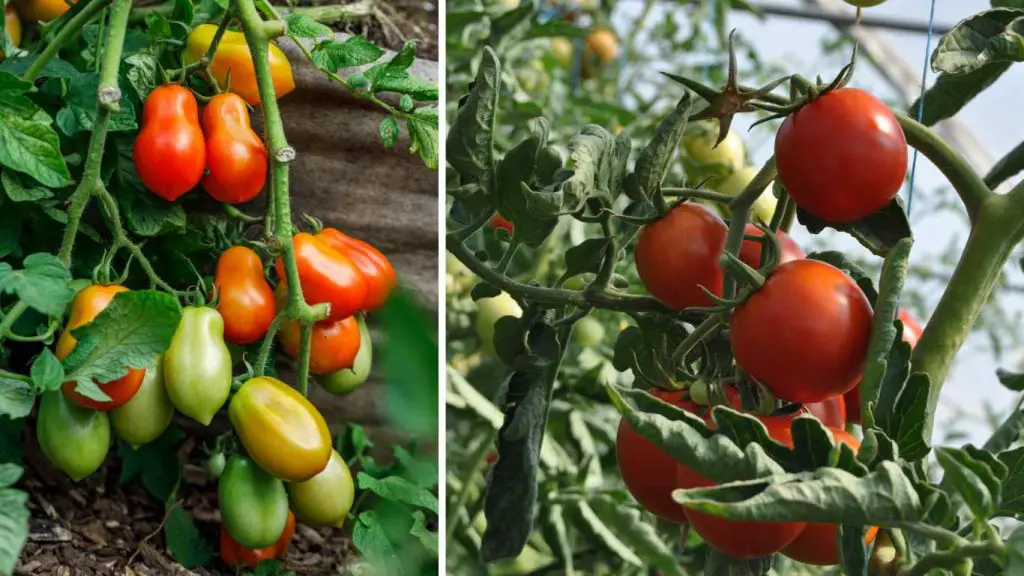
We’ll go over ten crucial tips in this tutorial to help you grow large, tasty tomatoes that are ideal for juicing.
1: Select the Correct Varieties of Tomatoes:
The best tomato types for juicing are determined by several criteria, including disease resistance, yield, flavor, and texture. The following are a few well-liked types that are well-suited for juicing:
Roma Tomatoes:
Also referred to as plum tomatoes, Roma tomatoes are used a lot for juicing because of their low seed content and meaty texture. Their thick and tasty juice is perfect for canning, sauces, and soups. They have a rich and tangy flavor. Roma tomatoes are also resistant to many common tomato illnesses and are comparatively easy to grow.
San Marzano Tomatoes:
Like Roma tomatoes, San Marzano tomatoes are valued for their sweet flavor, low moisture level, and dense flesh. They are great for juicing, producing a smooth, velvety juice that is frequently used in Italian cooking.
2: Start with High-Quality Seeds or Seedlings:
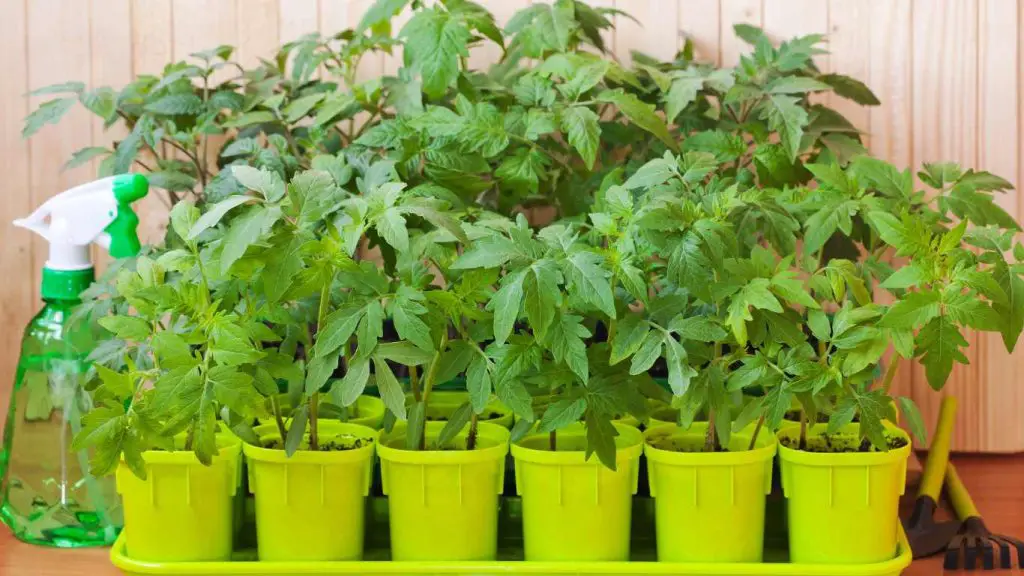
When cultivating juice tomatoes, choosing premium seeds is essential to guarantee a good crop of tasty, nutrient-dense fruits. Here is a thorough guide to assist you in selecting the finest seeds:
Select a Reputable Provider:
Begin by acquiring seeds from a source that has a solid reputation for providing high-quality items. Seek out seed companies or nurseries that have a solid reputation for producing high-quality seeds and excellent ratings.
Select Hybrid or Heirloom Varieties:
Choose between growing hybrid or heritage tomatoes. Open-pollinated heirloom cultivars have been passed down through the centuries and are frequently valued for their distinctive flavors. The consequence of carefully crafted crosses between various parent plants is the hybrid variety.
Think About Disease Resistance:
Choose tomato cultivars that are resistant to common ailments like tomato mosaic virus, fusarium wilt, and verticillium wilt. Disease-resistant cultivars lessen the chance of crop loss since they are more likely to flourish in a range of growing environments and yield nutritious fruits.
Examine Particular Types:
Examine particular tomato types that are well-known for being good for juicing. To make wonderful tomato juice, look for kinds that are described as “meaty,” “flavorful,” or “juicy.” The juice tomato types “Big Beef,” “San Marzano,” “Roma,” and “Amish Paste” are popular.
3: Give Your Plants Enough Sunshine:
Growing healthy and prolific tomato plants—especially those meant for juicing—requires enough sunlight. To ensure your juice tomatoes get adequate sunlight, follow these tips:
Choose the Correct Place:
Pick a bright area that gets at least 6 to 8 hours of direct sunshine every day, either in your garden or on your balcony. Avoid places that are shaded by other constructions, trees, or buildings.
Planting Bed Rotation:
If tomatoes are being grown in a garden bed, move them around every season to give them enough light and keep the soil from drying out.
Plant Sequentially:
To guarantee constant exposure to sunlight during the growth season, space out the planting of subsequent batches if you’re growing tomatoes in pots or a small area.
4: Adjust the Soil:
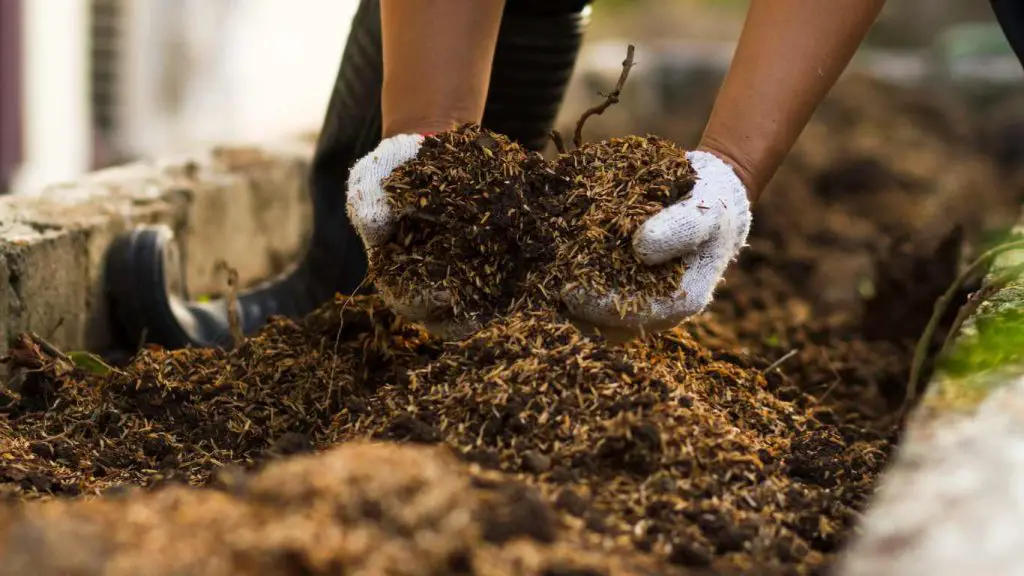
In order to cultivate juicy tomatoes, it’s critical to pay attention to a few crucial elements that support robust plant growth and plentiful fruit yield. This is a thorough guide to soil maintenance, amendment, and preparation:
Soil Testing:
To ascertain the pH level and nutrient composition of the soil, test it before making any changes. You can send samples to a nearby agricultural extension office for analysis, or you can buy DIY kits for soil testing. Generally speaking, tomatoes like slightly acidic soil that has a pH of 6.0 to 6.8.
Enrichment of Nutrients:
Because tomatoes are heavy feeders, they need a balanced diet to support healthy development and fruit production.
Use a complete fertilizer or organic matter rich in potassium, phosphorus, and nitrogen, like composted manure or bone meal, to modify the soil before planting.
Calcium Supplementation:
Make sure the soil has enough calcium to prevent blossom end rot, a common tomato disease brought on by a calcium deficit. Before planting, add gypsum or broken eggshells to the soil because calcium is necessary for the proper development of fruit.
Fertilization Schedule:
To maintain healthy plant growth and fruit development throughout the growing season, use side dressings of compost or balanced fertilizer every four to six weeks to boost soil nutrients.
Related Articles:
Pest and Disease Management:
Keep an eye out for symptoms of diseases like blight and wilt, as well as pests like hornworms, whiteflies, and aphids on tomato plants. When necessary, apply chemical or organic controls to stop infestations and reduce damage.
By following these instructions to modify the soil and create ideal growth conditions, you can grow tomatoes that are juicy and flavorful, pleasing your palate.
When harvest time arrives, don’t forget to thoroughly observe your plants, take quick care of any problems, and enjoy the results of your labor!
5: Ensure Appropriate Spacing:
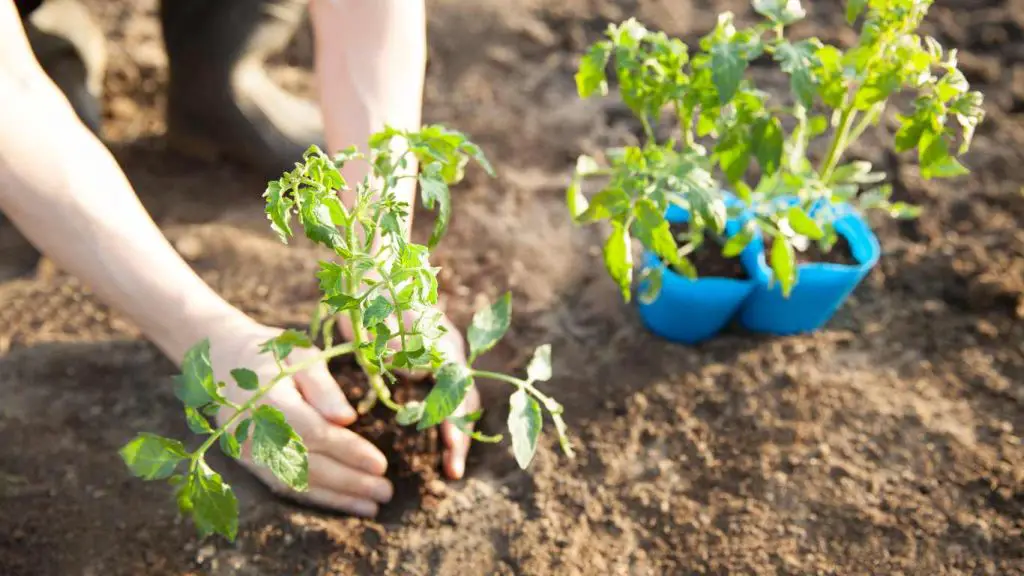
Juice tomato plants require proper spacing to maximize yield and maintain healthy plant growth.
Determine Spacing:
To thrive and yield fruit effectively, tomato plants need enough room to spread out. Plants for juice tomatoes should be 18–24 inches apart in rows that are 3–4 feet apart. Juice tomatoes are usually indeterminate kinds (growing like vines).
Related Articles: How Many Tomato Plants In A 4×4 Raised Bed?
6: Provide Support:
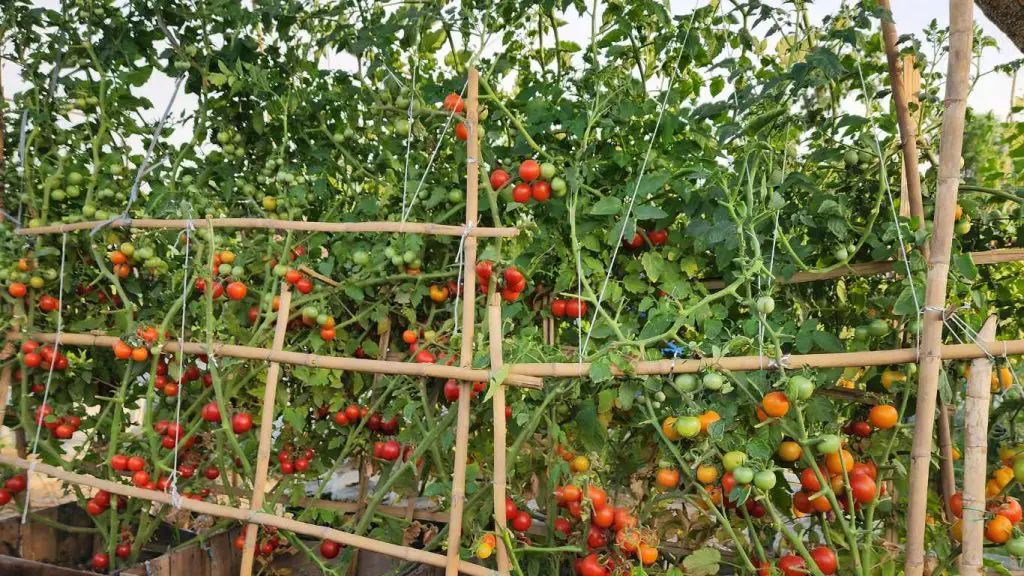
To maintain optimal growth and productivity, it is necessary to take many procedures to support the developing juice tomatoes:
Staking or Trellising:
Staking or trellising helps keep juice tomatoes upright as they grow, just like it does other tomato kinds. This lowers the risk of disease, keeps the vines from sprawling on the ground, and facilitates harvesting.
Choosing the Proper Support System:
Make sure your trellises or posts are strong enough to support the weight of your tomato plants and the fruit they bear. Depending on the particular requirements of your tomato variety and garden space, you may choose to use cages, stakes, or a trellis system.
Related Articles: 10 Best Trellis Ideas For Vertical Gardening
7: Water Regularly:
Watering your tomatoes regularly is essential for growing big, juicy ones.
Establish a Frequent Watering Schedule:
To keep the soil from entirely drying out, establish a regular watering schedule. Depending on the weather, tomatoes often require 1-2 inches of water per week.
Water Deeply:
To stimulate roots to grow downward in search of moisture, water deeply. Plants with shallow root systems are more vulnerable to stress and disease, which can be caused by shallow watering.
Mulching:
To maintain soil moisture and lower evaporation, spread an organic mulch layer at the base of tomato plants. Additionally, mulch helps control soil temperature by keeping it cooler in warmer weather.
Monitor Soil Moisture:
Make sure the soil surrounding your tomato plants is consistently moist. Insert your finger approximately one inch into the earth. It needs watering if it seems dry.
Avoid Overwatering:
Tomatoes prefer to avoid sitting in soggy soil, even if plants require constant moisture. Rotten roots and other problems might result from overwatering. To avoid soggy circumstances, let the soil dry out a little bit between waterings.
8: Fertilize Often:

To encourage strong root growth and fruit production, fertilize your tomato plants on a regular basis with a balanced fertilizer that is high in phosphate (P) and potassium (K). Observe the fertilizer package’s suggested application rates.
Related Articles:
- 10 Magical And Organic Fertilizers For Your Vegetable Garden
- Best Source Of Calcium For Tomato Plants And Other Vegetables
- How To Make Liquid Fertilizer From Compost For Vegetables?
9: Pruning With Wisdom:
To promote greater fruit production, remove suckers, which are the tiny shoots that emerge in the crotch between the main stem and branches. Additionally, pruning increases ventilation and lowers the chance of illness.
10: The Best Time to Harvest:
For juice tomatoes to have the best possible flavor, juiciness, and nutritional value, harvesting when they are at their peak is essential.
Several variables, including the tomato type, the surrounding environment, and the intended purpose, need to be taken into account when determining the ideal time to harvest.
Variety Selection:
The maturation times and attributes of various tomato cultivars differ. Whereas indeterminate types provide fruit continually throughout the growing season, determinate kinds often produce fruit that ripens all at once, making them ideal for large-scale harvesting.
Vegetables with a high juice content and flavor, such as Roma, San Marzano, and Amish Paste, are the best choices for juicing.
Weather:
One of the biggest factors in deciding when to harvest tomatoes is the current weather. Fruit can be negatively impacted by extreme heat, heavy rain, or protracted drought in terms of flavor, texture, and overall quality.
To minimize the risk of disease and avoid waterlogging, tomatoes are best harvested in dry weather.
Time of Day:
Tomatoes retain their freshness and flavor best when harvested in the cooler hours of the day, such as early morning or late afternoon. Tomatoes can easily get mushy and lose moisture when exposed to high midday temperatures.
Tomatoes can be harvested early in the morning or late in the afternoon so that they can be processed quickly and still be suitable for juicing.
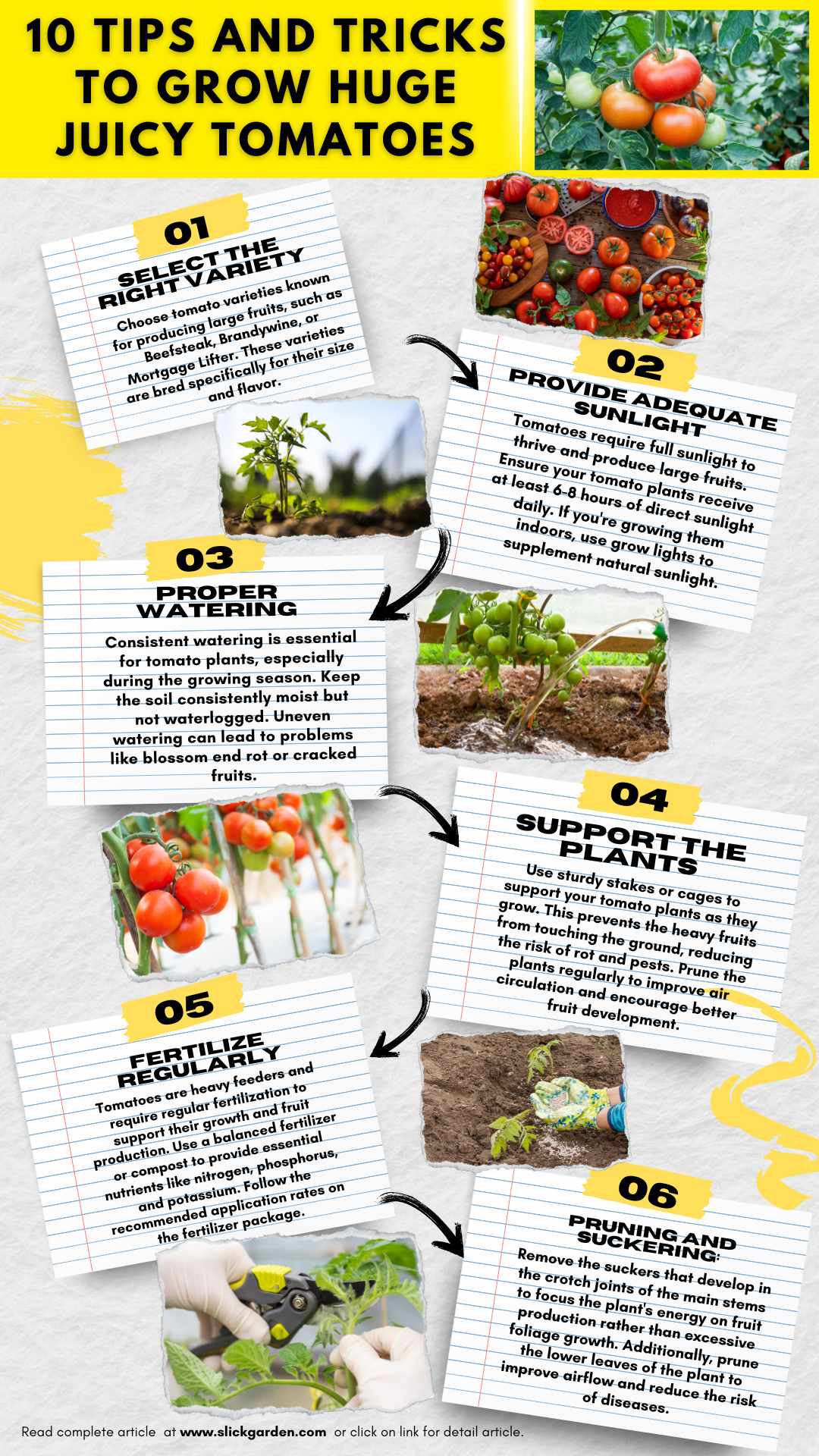
Conclusion:
You may raise your chances of producing large, juicy tomatoes that are ideal for creating delectable fresh juice by adhering to these ten tips.
